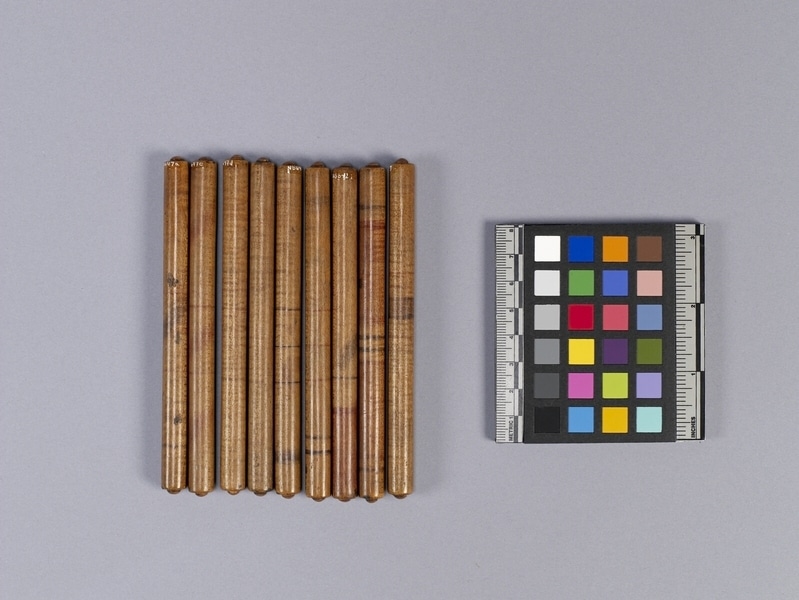Gambling Game Sticks Item Number: Nb647 a-i from the MOA: University of British Columbia

Description
Game sticks composed of nine cylindrical sticks that have a small, raised round knob at each end, and faint black and red lines on a polished surface: a) one thin black line at one end, three equidistant thin red lines at centre, black staining; b) two thin black lines at one end, three equidistant red lines at centre, light black staining; c) plain, no design; d) plain, no design; e) three thin red equidistant lines at centre, three faint, red diagonal lines equally spaced over surface; f) thick black lines at one end, three thin, equidistant black lines at centre, light black staining around one end; g) slightly off-centre, thick black line is bordered by thin red lines; h) series of lines, one thin red, one thick black, thin red, thick red, two thin red; i) thick black lines border two wide red bands.
History Of Use
Games of chance have long been popular among the native people of the Northwest Coast. Several different types of games were played; 'hand' and 'stick' games involved an opponent guessing where a specially marked stick, disk or bone was located. These games were played by men and apparently for very high stakes. Counters were used to keep score. It was believed that supernatural powers could affect the outcome of a game, therefore ritual preparations for games were important. Hand games were introduced to the northern areas from the south, where they remain popular today.
Cultural Context
gambling
Item History
- Made in British Columbia, Canada before 1935
- Owned by Barnabas Cortland Freeman
- Owned by John E. Gibbard before March 17, 1983
- Received from John E. Gibbard (Donor) on March 17, 1983
What
- Name
- Gambling Game Sticks
- Identification Number
- Nb647 a-i
- Type of Item
- game stick
- Material
- pigment and maple wood ?
- Manufacturing Technique
- polished, applied, cut and abraded
- Overall
- height 12.5 cm, diameter 1.0 cm
Who
- Culture
- Northwest Coast
- Previous Owner
- Barnabas Cortland Freeman and John E. Gibbard
- Received from
- John E. Gibbard (Donor)
Where
- Holding Institution
- MOA: University of British Columbia
- Made in
- British Columbia, Canada
When
- Creation Date
- before 1935
- Ownership Date
- before March 17, 1983
- Acquisition Date
- on March 17, 1983
Other
- Condition
- good
- Current Location
- Case 31
- Accession Number
- 0871/0001